12.02.2023
China's Shenzhou 15 astronauts take their 1st spacewalk outside Tiangong space station
Mission commander Fei Junlong and Zhang Lu performed a seven-hour-long EVA on Feb. 9.

Commander Fei Junlong during the first Shenzhou 15 mission spacewalk, on Feb. 9, 2023, imaged by Wentian module panoramic camera B. (Image credit: CMSA)
Two Chinese astronauts headed outside the nation's Tiangong space station on Thursday (Feb. 9) for a seven-hour-long spacewalk, the first of the ongoing Shenzhou 15 mission.
Shenzhou 15 mission commander Fei Junlong and Zhang Lu exited the Wentian experiment module airlock in the early morning hours of Feb. 9 and returned inside at 11:16 a.m. EST (1616 GMT) after completing a series of tasks. The third Shenzhou 15 mission member, Deng Qingming, supported his crewmates from inside Tiangong.
The duo of Fei and Zhang installed external pumps outside Mengtian during the spacewalk, to aid the thermal control and function of the experiment module and the science apparatus mounted on its exterior.
Fei and Zhang also performed tasks related to Mengtian's payload airlock, which allows astronauts using the station's robotic arms to deploy science payloads and small satellites. Experiments were installed outside Mengtian using the airlock for the first time in January.
Mengtian launched in November last year, and its arrival at Tiangong marked the completion of the T-shaped orbital outpost.
China's human spaceflight agency announced(opens in new tab) that the extravehicular activity had taken place only after its completion. It did not provide a start time for the EVA. The agency had stated(opens in new tab) somewhat vaguely on Wednesday (Feb. 8) that the planned spacewalk would take place in the near future.
The three Shenzhou 15 crewmates launched to the Tiangong space stationon Nov. 29 of last year and have now spent more than 70 days in orbit. They are expected to conduct two to three further EVAs during their six-month-long mission.
The arrival of Shenzhou 15 at Tiangong to join the Shenzhou 14 crew marked China's first crew handover and the start of the operational phase of the newly constructed space station. The country plans to keep the space station permanently crewed for at least a decade.
Quelle: SC
----
Update: 18.02.2023
.
China Focus: Shenzhou-14 astronauts meet press after quarantine, initial recovery

Chinese astronauts Chen Dong (2nd R), Liu Yang (1st R) and Cai Xuzhe (3rd R), the three Shenzhou-14 crew members, salute during a press conference in Beijing, capital of China, Feb. 17, 2023. The three astronauts of China's Shenzhou-14 crewed mission met with press on Friday, in their first such appearance since returning to Earth in December. (Xinhua/Guo Zhongzheng)
The three astronauts of China's Shenzhou-14 crewed mission met with press on Friday, in their first such appearance since returning to Earth in December.
The astronauts have completed their quarantine and recuperation stages, and have now moved to the observation stage, according to the press conference held at the Astronaut Center of China in Beijing.
At present, the crew are in good physical and mental condition. Their weights are at the same levels as they were prior to their missions, and they have restored their muscle strength, endurance and cardio functions further.
They will resume their regular training after completing health assessments.
Launched on June 5, 2022, the Shenzhou-14 spaceship sent Chen Dong, Liu Yang and Cai Xuzhe to China's space station core module Tianhe.
They completed multiple tasks during their six-month mission, including performing three extravehicular activities, giving a live online science lecture, and cooperating with ground control to complete the assembly and construction of the space station's T-shape structure.
Chen Dong, the mission commander, became the first Chinese astronaut to live in orbit for over 200 days. He said that timely and effective ground support was a strong backing for the team to complete the mission successfully.
Liu Yang is China's first female astronaut. She said she was very excited to witness the enormous progress of China's aerospace science and technology sector compared with 10 years ago, when she first traveled into space. She also said she was honored to witness the formation of the space station's basic configuration.
Reflecting on her 183 days in space, she said that she could never forget the beauty of the universe, meeting with the Shenzhou-15 crew aboard the space station, or the cards her husband wrote her and the songs her children sang for her when she celebrated her birthday.
"I am proud of my country," said Cai Xuzhe, whose dream of traveling into space became a reality after 12 years of training and waiting. "All I need to do now is summarize the experience obtained from this mission and enter follow-up training in my best condition. I am looking forward to returning to space." ■
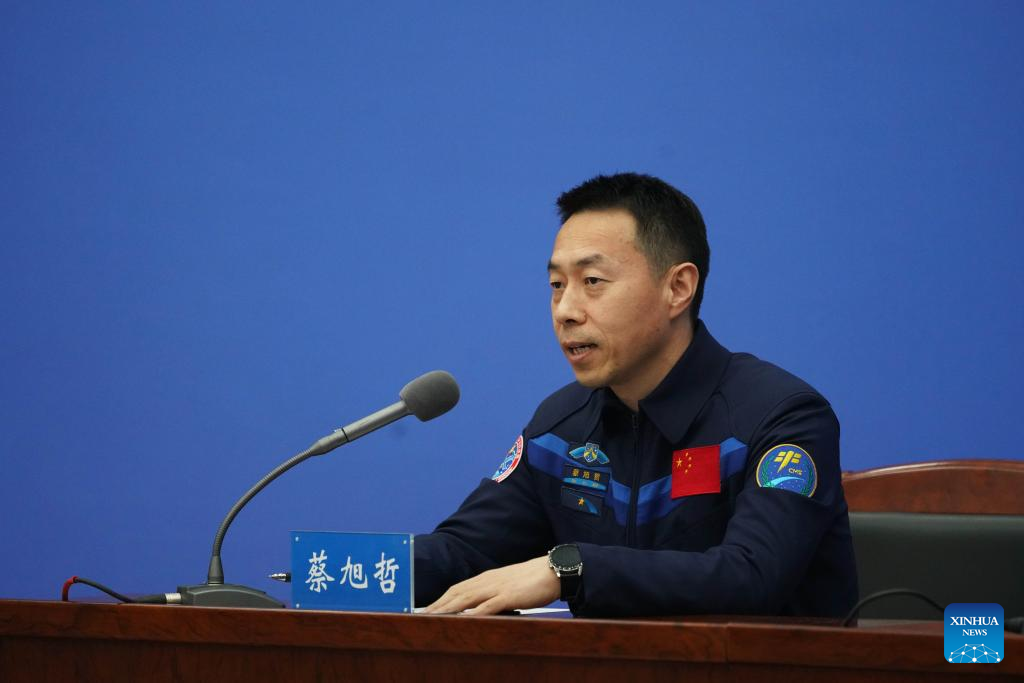
Chinese astronaut Cai Xuzhe, a Shenzhou-14 crew member, speaks during a press conference in Beijing, capital of China, Feb. 17, 2023. The three astronauts of China's Shenzhou-14 crewed mission met with press on Friday, in their first such appearance since returning to Earth in December. (Xinhua/Guo Zhongzheng)
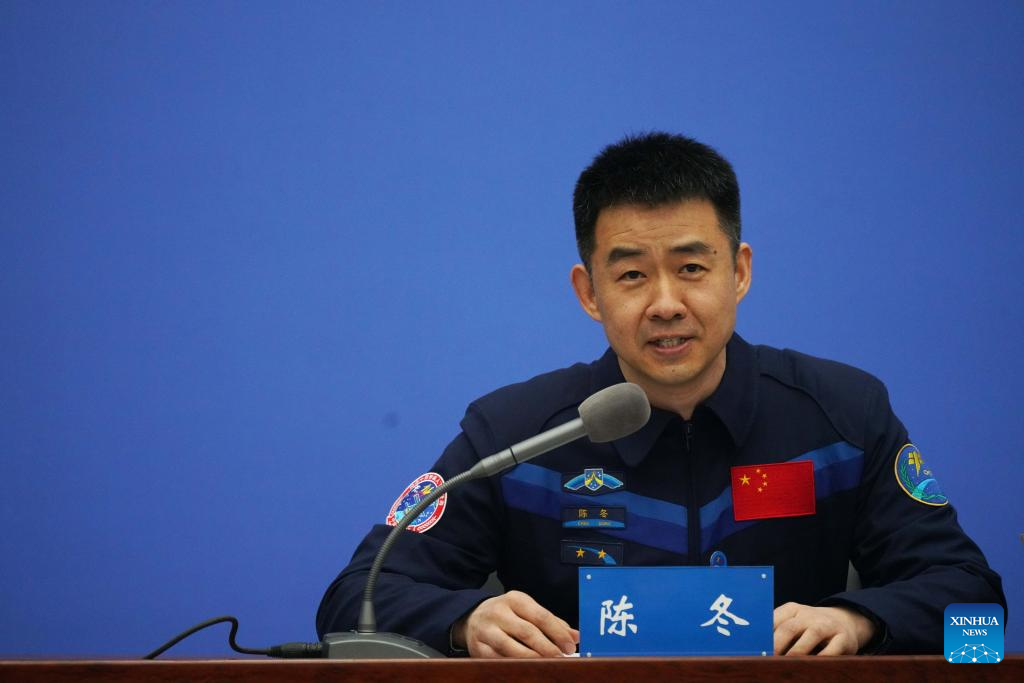
Chinese astronaut Chen Dong, a Shenzhou-14 crew member, speaks during a press conference in Beijing, capital of China, Feb. 17, 2023. The three astronauts of China's Shenzhou-14 crewed mission met with press on Friday, in their first such appearance since returning to Earth in December. (Xinhua/Guo Zhongzheng)
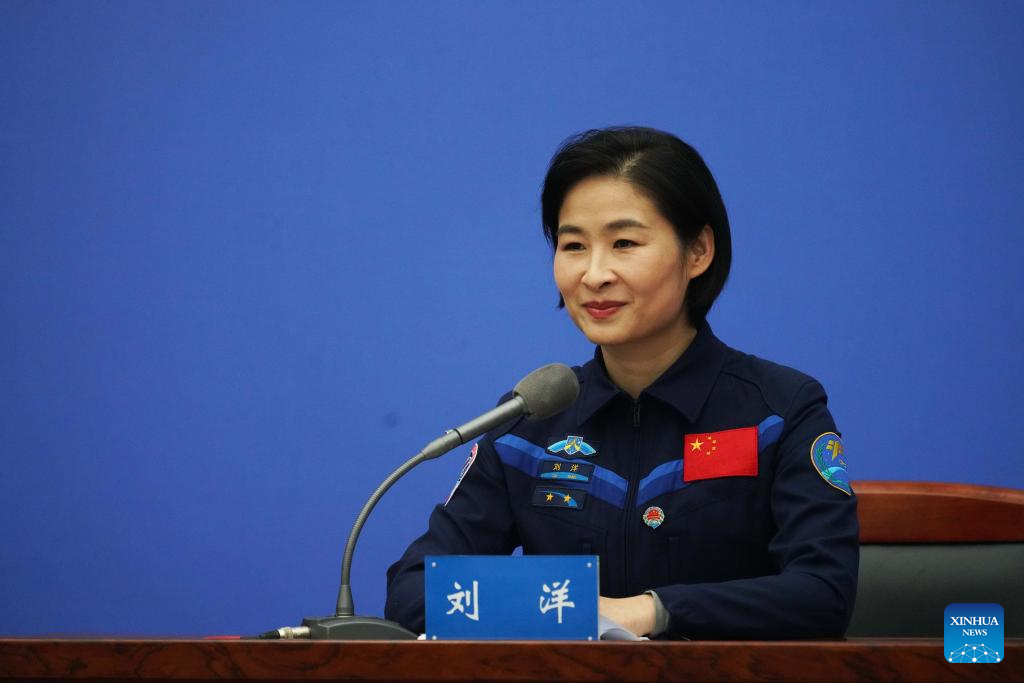
Chinese astronaut Liu Yang, a Shenzhou-14 crew member, attends a press conference in Beijing, capital of China, Feb. 17, 2023. The three astronauts of China's Shenzhou-14 crewed mission met with press on Friday, in their first such appearance since returning to Earth in December. (Xinhua/Guo Zhongzheng)
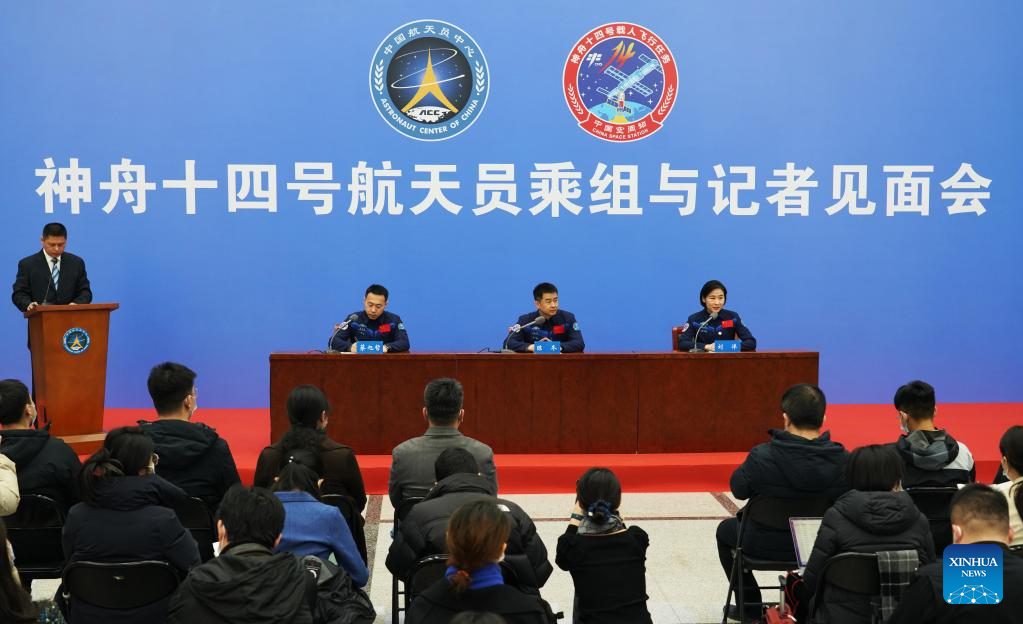
The Shenzhou-14 crew members attend a press conference in Beijing, capital of China, Feb. 17, 2023. The three astronauts of China's Shenzhou-14 crewed mission met with press on Friday, in their first such appearance since returning to Earth in December. (Xinhua/Guo Zhongzheng)
Quelle: Xinhua
----
Update: 1.03.2023
.
China Focus: Two-photon microscope captures cell images of astronauts in orbit
The in-orbit Chinese astronauts of the Shenzhou-15 crew successfully obtained the three-dimensional structural images of their skin cells with the country's self-developed two-photon microscope, its developer announced Monday.
The event, the first of its kind worldwide, marked the success of the in-orbit verification experiments of the two-photon microscope, providing a promising tool for future health monitoring of astronauts in orbit.
Designed for astronauts on China's space station, the portable two-photon microscope was developed by a joint research team of scientists from Chinese universities, institutions, and enterprises, including Peking University, the Astronaut Center of China, and Beihang University, based on the support from the China Manned Space Agency.
A nonlinear optical imaging technology based on two-photon absorption and fluorescence excitation, two-photon microscopy can penetrate deeply into living tissues, featuring high-resolution, large imaging depth, and three-dimensional tomographic ability, among others.
The previous two-photon microscopes across the globe had not realized the in-orbit operation and application due to their large size, which failed to meet the requirements for in-orbit experiment equipment, such as volume, weight, and impact resistance.
A miniature two-photon microscope with a probe weighing only 2.2 grams was developed in 2017 by Cheng Heping, director of the National Biomedical Imaging Center at Peking University and head of the joint research team, after his team made breakthroughs in major core technologies of two-photon microscopic miniaturization. The microscope laid the technical foundation for the present in-orbit one.
Last November, the two-photon microscope used by the Shenzhou-15 astronauts was sent to China's space station onboard the Tianzhou-5 cargo craft.
It was installed by the crew recently before capturing three-dimensional structural images of skin epidermis and superficial dermis on their faces and forearms, said Wang Junjie, a team member from the College of Future Technology under Peking University.
The images showed clear three-dimensional structures of the skin layers, including the stratum corneum, the stratum granulosum, the stratum spinosum, the stratum basale, and the superficial dermis, indicating the success of the in-orbit verification experiments of the two-photon microscope, Wang added.
With a resolution reaching submicron level, the microscope also features noninvasive microscopic imaging when showing the three-dimensional distribution of the astronauts' skin structure and their cells clearly.
In the two-photon microscopic imaging, the signals can be observed through spontaneously fluorescent substances in cells and extracellular matrix, and play an important role in examining the metabolic stress response of mitochondria inside the astronauts' cells, thus monitoring their health conditions in orbit.
The first success of the in-orbit operation of the two-photon microscope reflects China's high level of high-end precision optical instrument manufacturing, said Cheng.
He explained that the success offers new methods for in-orbit health monitoring of astronauts at the cellular and molecular levels and provides vital technical means for the country to carry out in-orbit brain science research in the future.
Quelle: Xinhua
----
Update: 2.03.2023
.
China to expand its space station, international astronaut selection underway

HELSINKI — China is planning to expand its Tiangong space station with a multi-functional module to enhance its capabilities.
China completed the construction of the three-module Tiangong space station last November, realizing a plan first approved in 1992.
The operational phase of the station began with a first crew handover late last year. China plans to keep Tiangong permanently inhabited for at least a decade with crews of three spending six months at a time in orbit.
Already though, new plans are emerging. “We will launch the expansion module of the space station at an appropriate time to further expand the size of the space station and enhance its capacity,” Ji Qiming, assistant to director of the China Manned Space Engineering Office (CMSEO), told CCTV Feb. 24.
The expansion module appears to have superseded earlier an apparent plan to send up duplicates of the existing three, roughly 20-metric-ton modules.
The multi-functional expansion module will host six docking ports and turn the T-shaped Tiangong into a cross-shaped configuration.
The added ports will provide redundancy and allow more spacecraft to dock at Tiangong than present. This would also help facilitate plans to allow commercial spacecraft and tourist visits to the orbital outpost.
Ji discussed the expansion plan with Chinese state media at an exhibition to mark three decades of China’s human spaceflight program. He also revealed progress on China’s plans to land astronauts around the end of the decade.
Tianhe, the space station core module, was the first piece of the station to be launched back in April 2021. It provides the main propulsion and life support systems and crew quarters for the astronauts on Tiangong and carries a docking hub to facilitate the arrival of spacecraft and further modules.
Images from facilities at the China Academy of Space Technology (CAST), the maker of China’s space station modules, suggested that backup or engineering models had been developed and could be readied for use in orbit.
The smaller, multi-functional module resembles some outward design features of Tianhe but would not require all of the core module’s systems and capabilities to be replicated. Its docking ports would however still allow for the arrival of new experiment modules to expand further.
The country will also launch a co-orbiting optical telescope module, named Xuntian, in 2024. It will be capable of docking with Tiangong for repairs, maintenance, refueling and upgrades.
In an adjacent development, CMSEO officials revealed that it is preparing for international visits to Tiangong.
“We are about to start selecting international astronauts to send to our space station and carry out scientific experiments together,” Chen Shanguang, a deputy chief designer of China’s human spaceflight program, told CCTV.
“Coming to China’s space station and taking a Chinese rocket to space requires familiarity with China’s spacecraft. This may have to wait until they arrive in China so that our instructors can train them,” Chen said.
The move is part of China’s plans to use Tiangong to boost its international space cooperation and soft power.
Many countries have proposed sending astronauts to visit Tiangong, according to Chen, who did not name specific states.
The European Space Agency will not be sending its astronauts, however, despite earlier training exchanges with China. ESA Director General Josef Aschbacher said in January that the agency had neither the budget nor the political green light for participating in the Chinese space station.
Meanwhile experiments selected by a joint program between the CMSA and the United Nations Office for Outer Space Affairs (UNOOSA) could begin flying to Tiangong this year.
Quelle: SN
----
Update: 3.03.2023
.
Shenzhou-15 taikonauts complete their second spacewalk
The Shenzhou-15 taikonauts on board the orbiting Chinese Tiangong space station recently completed their second spacewalk, according to the China Manned Space Agency.
Fei Junlong and Zhang Lu, together with Deng Qingming who worked inside the space station to support his crewmates, collaborated to accomplish all set tasks. Fei and Zhang safely returned to the Wentian lab module.
The three-man crew have been living in orbit for three months since they entered the space station combination on Nov. 30, 2022.
They have completed various tasks, including two extravehicular activities, continuous maintenance of the manned environment, the assembling and testing of the scientific experiment cabinets of the Wentian and Mengtian lab modules, and sending cargo outboard.
Quelle:Xinhua
----
Update: 5.03.2023
.
China's Shenzhou 15 astronauts perform 2nd spacewalk and 1st 'fire in space' test
The three spaceflyers have been busy aboard China's Tiangong space station.

China's Shenzhou 15 astronauts are keeping busy on the nation's Tiangong space station.
Two of the three Shenzhou 15 spaceflyers — Fei Junlong and Zhang Lu — conducted a spacewalk outside Tiangong recently, officials with the China Manned Space Engineering Office (CMSEO) said in an update on Wednesday(opens in new tab)(March 1). Fellow crewmate Deng Qingming supported the excursion from inside the station.
Fei and Zhang "successfully completed all the scheduled tasks and returned safely to the Wentian experimental cabin," CMSEO officials wrote (in Chinese; translation by Google), without specifying what those tasks were or when exactly the spacewalk took place. Wentian is one of the T-shaped Tiangong's three modules; the others are Mengtian and Tianhe.
The extravehicular activity (EVA) was the second for the Shenzhou 15 astronauts, who arrived at Tiangong on Nov. 29, 2022. The other spacewalk occurred on Feb. 9.
The Shenzhou 15 astronauts have also made significant scientific progress during the first three months of their six-month mission, according to the CMSEO update.
For example, the spaceflyers worked together with ground personnel to inaugurate the "combustion science cabinet" installed in Mengtian, performing its first-ever on-orbit ignition test.
The trial "verified the completeness of the functions of the space station combustion science experiment system and the accuracy of the overall experimental process," paving the way for future projects, CMSEO officials wrote.
In addition, the two-photon microscope(opens in new tab)that launched to Tiangong aboard the Tianzhou 5 cargo spacecraft on Nov. 11, 2022 has been doing work in orbit. The instrument has taken images of the Shenzhou 15 crewmembers' skin cells, according to the update.
The microscope "provides a new tool for on-orbit health monitoring of crewmembers," CMSEO officials wrote.
China launched Tiangong's Tianhe core module in April 2021, then lofted the Wentian and Mengtian segments in July 2022 and October 2022, respectively. Mengtian's attachment wrapped up the station's assembly phase.
Quelle:SC
+++
China selects mystery astronauts for 2023 missions to Tiangong space station
Chinese astronaut crews are usually revealed only a day ahead of launch.

China has selected the astronauts that will fly a pair of crewed missions to its Tiangong space station this year.
China will later this year send two crews to the now fully operational Tiangong to spend six months in orbit conducting science experiments and keeping the space station maintained.
Two three-person crews have been selected for the Shenzhou 16 mission, due to launch in May, and the following Shenzhou 17 mission, launching six months later. The missions will lift off atop Long March 2F rockets from Jiuquan in the Gobi Desert.
Each mission also has a backup crew selected that will be ready to fill a position in the primary crew, if required.
"Before the start of the spaceflight mission, we will select the astronauts one or one and a half years in advance, including the astronauts who will perform the mission and the backup crew," Yang Liwei, deputy chief designer of China’s human spaceflight program, told Chinese broadcaster CCTV.
"Now we've basically conducted astronaut selection for two missions together, and will select a backup crew," added Yang, who was also China's first astronaut in space.
Previously, the China Manned Space Agency (CMSA) would send a backup crew for a mission to space on the following flight. This appears to have changed and likely reflects the shifts required to adjust to launching crewed missions every six months.
China previously had a gap of nearly five years between 2016's Shenzhou 11 mission and Shenzhou 12, which marked the first visit to the Tiangong station’s core module back in 2021.
One thing that has not changed is China keeping the identities of the astronauts hidden until close to launch. Typically, CMSA, which is overseen by the People’s Liberation Army, only reveals a crew via a press conference a day before launch.
China recruited a third batch of new astronauts back in 2020. The 18 people — 17 men and one woman — should have completed basic training by now and could be eligible to fly in 2023. Their identities are not yet known.
CMSA began recruiting a fourth batch of astronauts in October. "Our first batch of astronauts selected were initially pilots from the air force, and now our astronauts come from colleges, universities, research institutions, engineering departments and the Chinese Academy of Sciences. People from all walks of life are eligible for selection," Yang said.
Quelle:SC
----
Update: 3.04.2023
.
China's Shenzhou-15 astronauts complete 3rd spacewalk
The astronauts of China's Shenzhou-15 crew have completed three spacewalks since their journey into space four months ago, according to the China Manned Space Agency (CMSA).
The third spacewalk was conducted on Thursday by astronauts Fei Junlong and Zhang Lu, in collaboration with the astronaut Deng Qingming who was inside the space station. The pair accomplished all their scheduled tasks before safely returning to the lab module Wentian, the CMSA said.
According to the CMSA, four crews have carried out a total of 10 spacewalks since the Shenzhou-12 manned mission in 2021, mastering a series of key technologies. Follow-up extravehicular activities will continue to be conducted regularly as planned.
In the past month, the Shenzhou-15 crew has completed various tasks, including the in-orbit maintenance of the space station. The Stirling thermoelectric convertor has also completed its in-orbit test. Capable of converting thermal energy into electricity with relatively high efficiency and power density, the convertor is expected to be used in future manned lunar missions and deep-space exploration, the CMSA said.
The Tianzhou-6 cargo craft is scheduled to be launched in early or mid-May, the CMSA said, adding that it has been transported to the Wenchang Spacecraft Launch Site in the southern province of Hainan.
Quelle: Xinhua
----
Update: 15.04.2023
.
China's Shenzhou 15 astronauts quietly conduct 3rd spacewalk
The nation has reduced the amount of information it provides about its EVAs.

China's Shenzhou 15 astronauts completed their third spacewalk in late March under a cloud of secrecy.
Astronauts Fei Junlong and Zhang Lu exited the Tiangong space stationsometime on March 30, with crewmate Deng Qingming assisting from inside the station.
China's human spaceflight agency, CMSA, only confirmed(opens in new tab) a day later that the extravehicular activity (EVA) took place. No details of the EVA's times and tasks were published. The spacewalk followed the example of the mission's second EVA, which was only officially revealed on March 1, after it had occurred.
Notably, the mission's first spacewalk, back in February, was a much more transparent event. The CMSA announced the EVA in advance and later reported the timing and objectives of the activity, and published video and images. This had been the practice for earlier spacewalks by crews visiting Tiangong.
It is unclear if the new restricted levels of information relate to operational sensitivity or a change in policy.
The three Shenzhou 15 astronauts have been living in orbit since arriving at Tiangong in their Shenzhou spacecraft in late November last year.
Since then, the Shenzhou 15 crew has completed a range of tasks, including maintaining the pressurized habitat aboard Tiangong, carrying out repairs, conducting scientific experiments including testing a Stirling thermoelectric converter, and installing new equipment to allow deployment of cubesats from the Mengtian science module.
The crew will greet the arrival of the Shenzhou 16 mission astronauts to Tiangong in May and hand over control of the station. Fei, Zhang and Deng will then head back to Earth, having completed their six-month-long mission.
China is currently preparing to launch the Tianzhou 6 cargo spacecraft to Tiangong to provide supplies for the upcoming mission. A Long March 7 rocket arrived at a port close to the Wenchang Satellite Launch Center in recent days. 2023 will also see China launch the Shenzhou 17 crewed mission around late November.
Shenzhou-15 taikonauts complete 4th spacewalk, setting China record

This screen image captured at Beijing Aerospace Control Center on April 15, 2023 shows Shenzhou-15 taikonaut Zhang Lu waving after performing extravehicular activities outside the Wentian lab module. The Shenzhou-15 taikonauts on board the orbiting Chinese Tiangong space station have completed their fourth spacewalk, the China Manned Space Agency said on Sunday. (Xinhua/Guo Zhongzheng)
The Shenzhou-15 taikonauts on board the orbiting Chinese Tiangong space station have completed their fourth spacewalk, the China Manned Space Agency said on Sunday.
Fei Junlong and Zhang Lu, together with Deng Qingming who worked inside the space station and the supporting team on the ground, collaborated to pull off all set tasks on Saturday. Fei and Zhang have since safely returned to the Wentian lab module.
The trio have now performed extravehicular activities on four occasions since they were launched into space in November 2022, setting a domestic record for the most spacewalks by a single crew.
During the latest extravehicular mission, they installed several items of equipment, including the extravehicular extended pump sets, the cross-module cables, and supporting devices for the extravehicular payload platform, laying a foundation for carrying out subsequent large-scale science and technology experiments outside the space station, the agency noted in a statement. ■
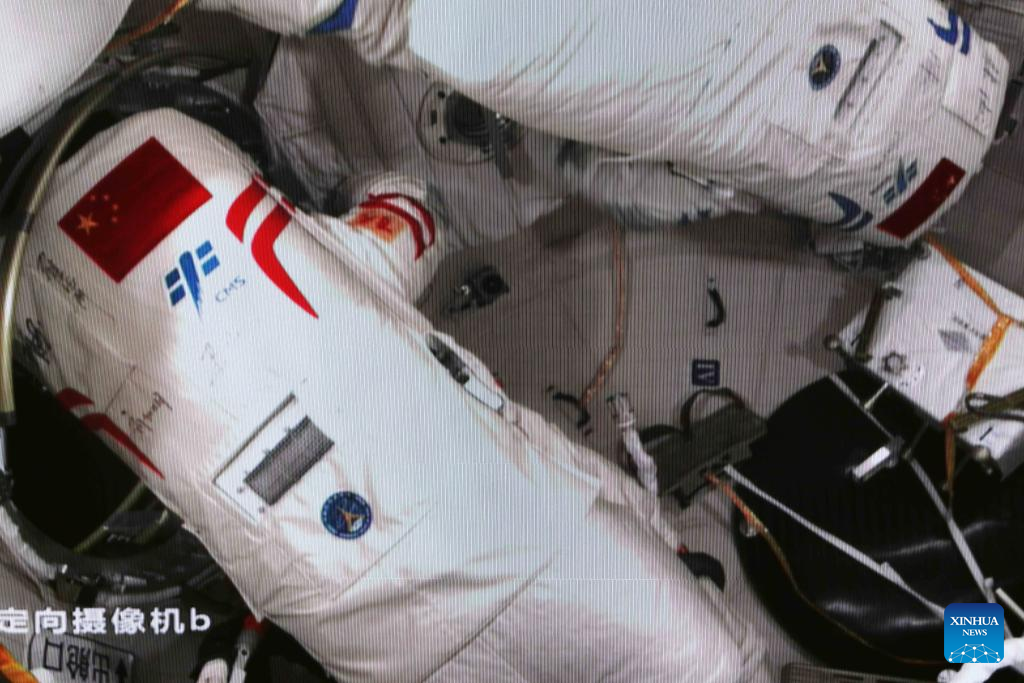
This screen image captured at Beijing Aerospace Control Center on April 15, 2023 shows Shenzhou-15 taikonaut Fei Junlong (L) getting ready to exit the Wentian lab module. The Shenzhou-15 taikonauts on board the orbiting Chinese Tiangong space station have completed their fourth spacewalk, the China Manned Space Agency said on Sunday. (Xinhua/Guo Zhongzheng)
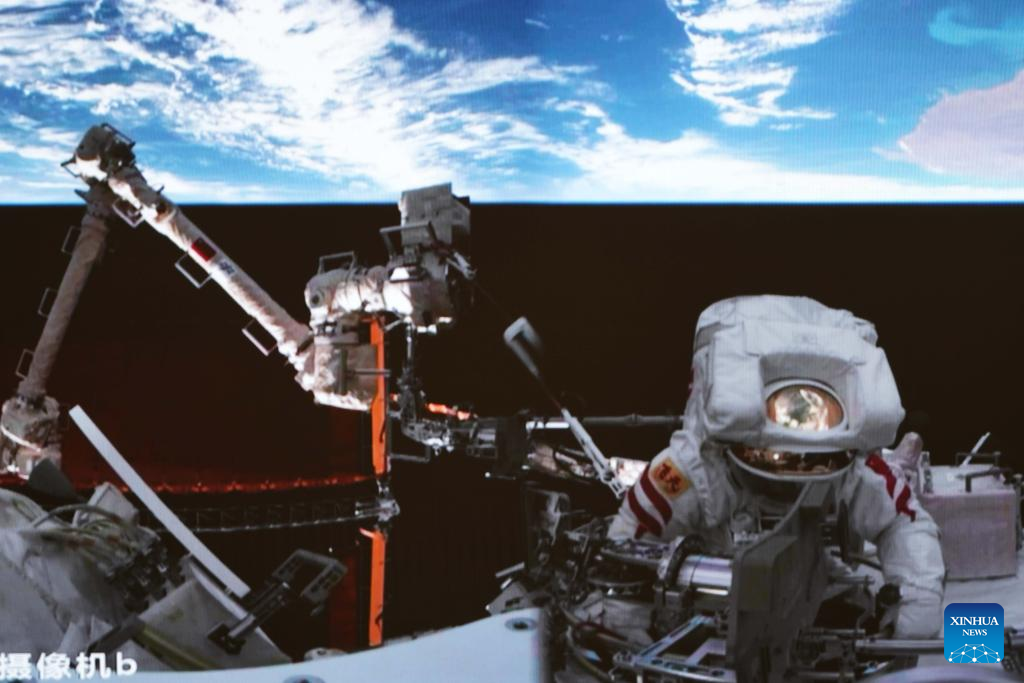
This screen image captured at Beijing Aerospace Control Center on April 15, 2023 shows Shenzhou-15 taikonaut Fei Junlong exiting the Wentian lab module. The Shenzhou-15 taikonauts on board the orbiting Chinese Tiangong space station have completed their fourth spacewalk, the China Manned Space Agency said on Sunday. (Xinhua/Guo Zhongzheng)
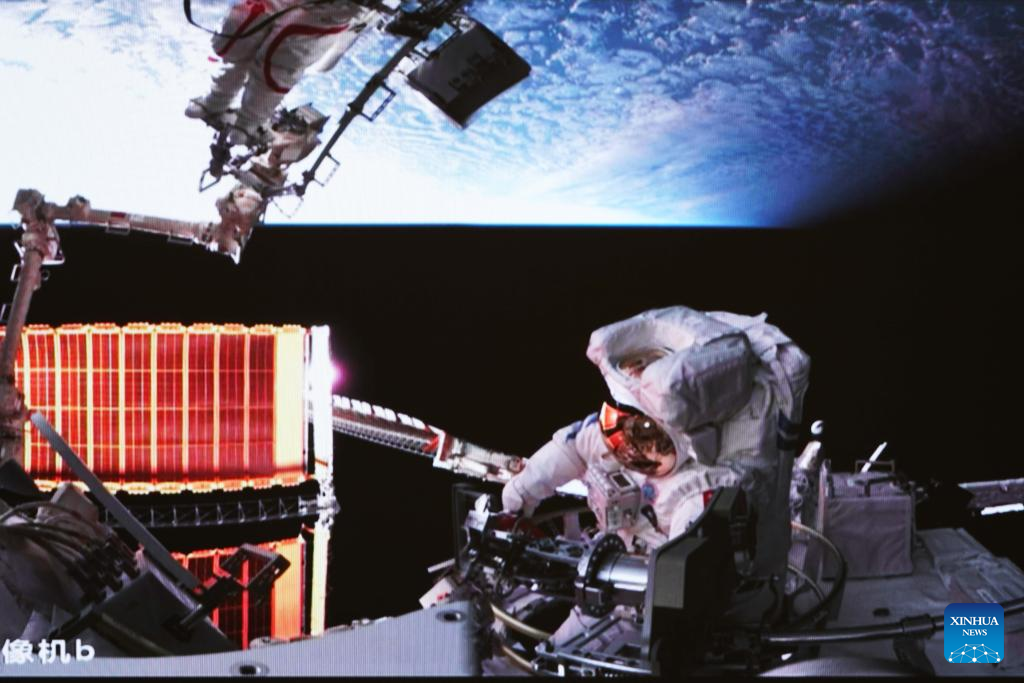
This screen image captured at Beijing Aerospace Control Center on April 15, 2023 shows Shenzhou-15 taikonaut Zhang Lu (below) exiting the Wentian lab module. The Shenzhou-15 taikonauts on board the orbiting Chinese Tiangong space station have completed their fourth spacewalk, the China Manned Space Agency said on Sunday. (Xinhua/Guo Zhongzheng)
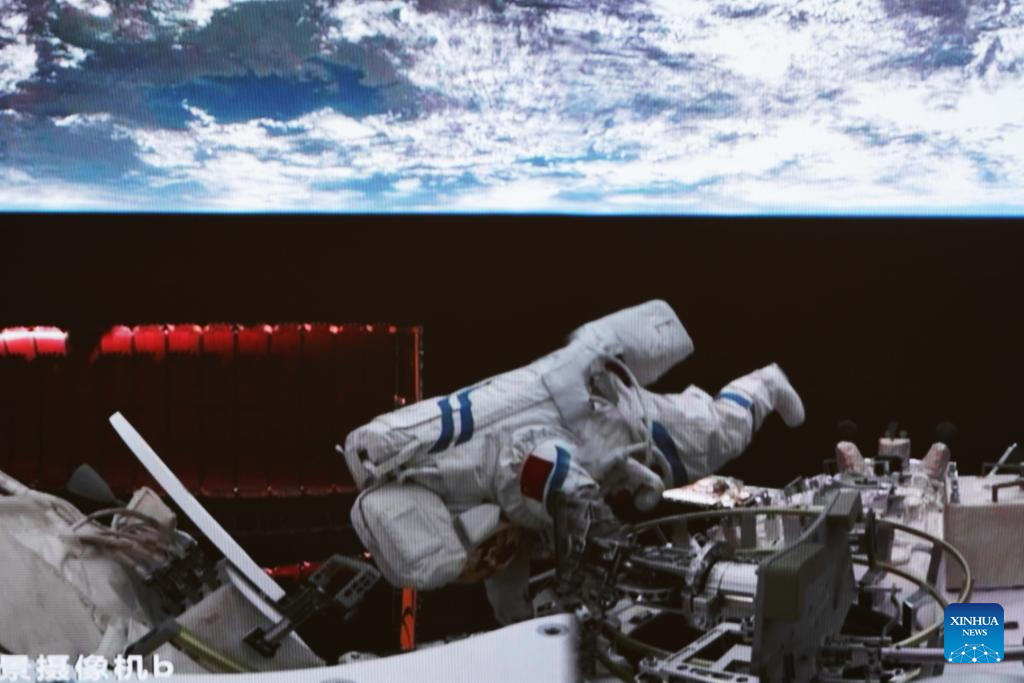
This screen image captured at Beijing Aerospace Control Center on April 15, 2023 shows Shenzhou-15 taikonaut Zhang Lu performing extravehicular activities outside the Wentian lab module. The Shenzhou-15 taikonauts on board the orbiting Chinese Tiangong space station have completed their fourth spacewalk, the China Manned Space Agency said on Sunday. (Xinhua/Guo Zhongzheng)
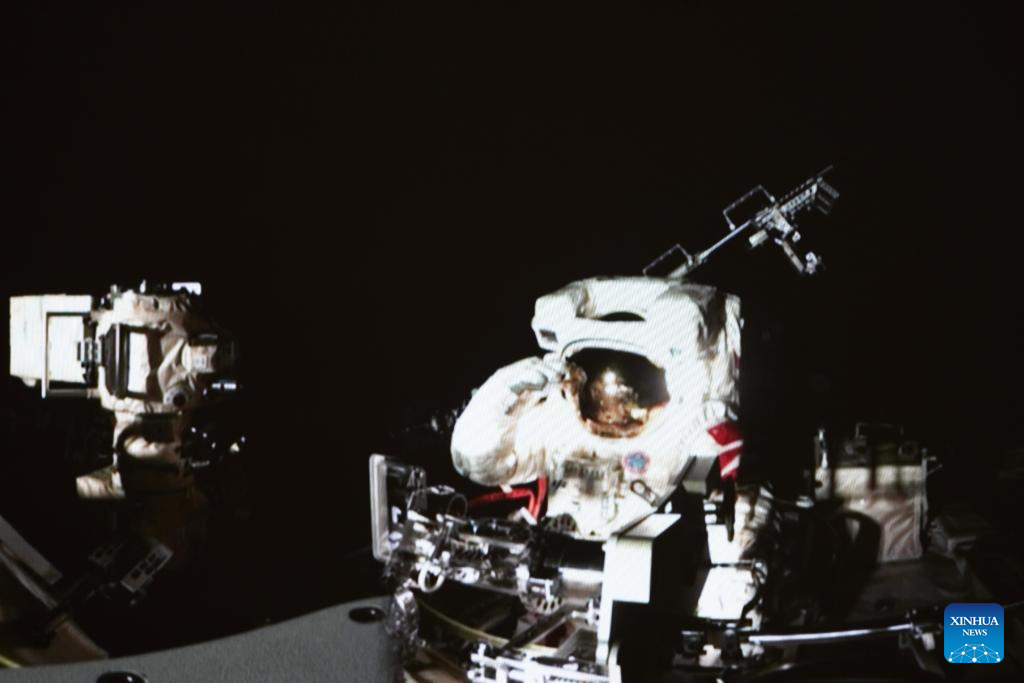
This screen image captured at Beijing Aerospace Control Center on April 15, 2023 shows Shenzhou-15 taikonaut Fei Junlong saluting after performing extravehicular activities outside the Wentian lab module. The Shenzhou-15 taikonauts on board the orbiting Chinese Tiangong space station have completed their fourth spacewalk, the China Manned Space Agency said on Sunday. (Xinhua/Guo Zhongzheng)
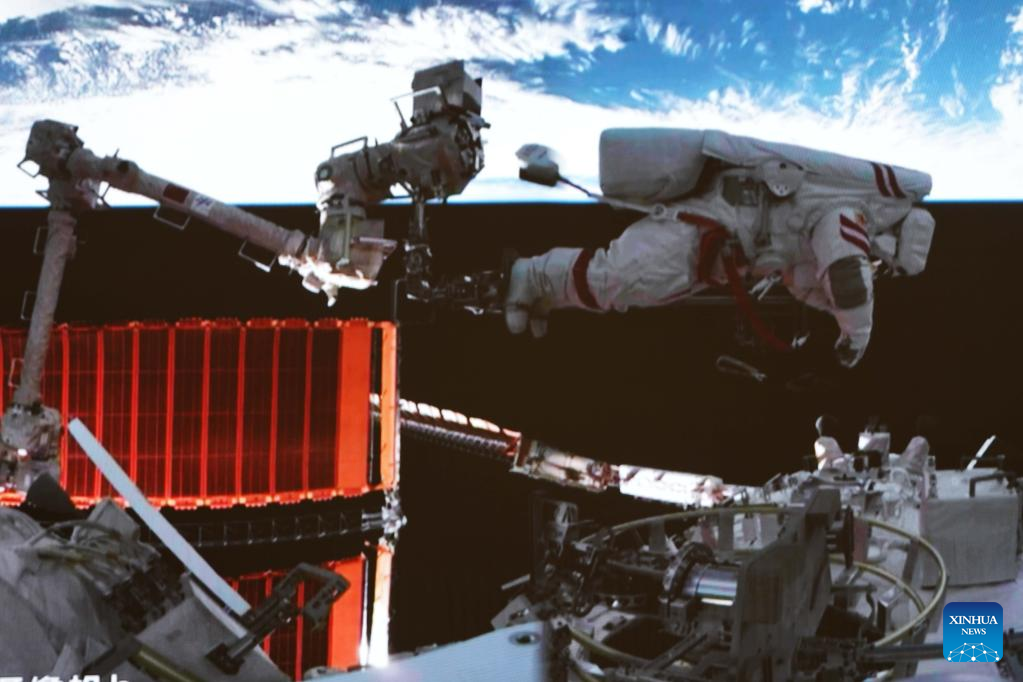
This screen image captured at Beijing Aerospace Control Center on April 15, 2023 shows Shenzhou-15 taikonaut Fei Junlong performing extravehicular activities outside the Wentian lab module. The Shenzhou-15 taikonauts on board the orbiting Chinese Tiangong space station have completed their fourth spacewalk, the China Manned Space Agency said on Sunday. (Xinhua/Guo Zhongzheng)
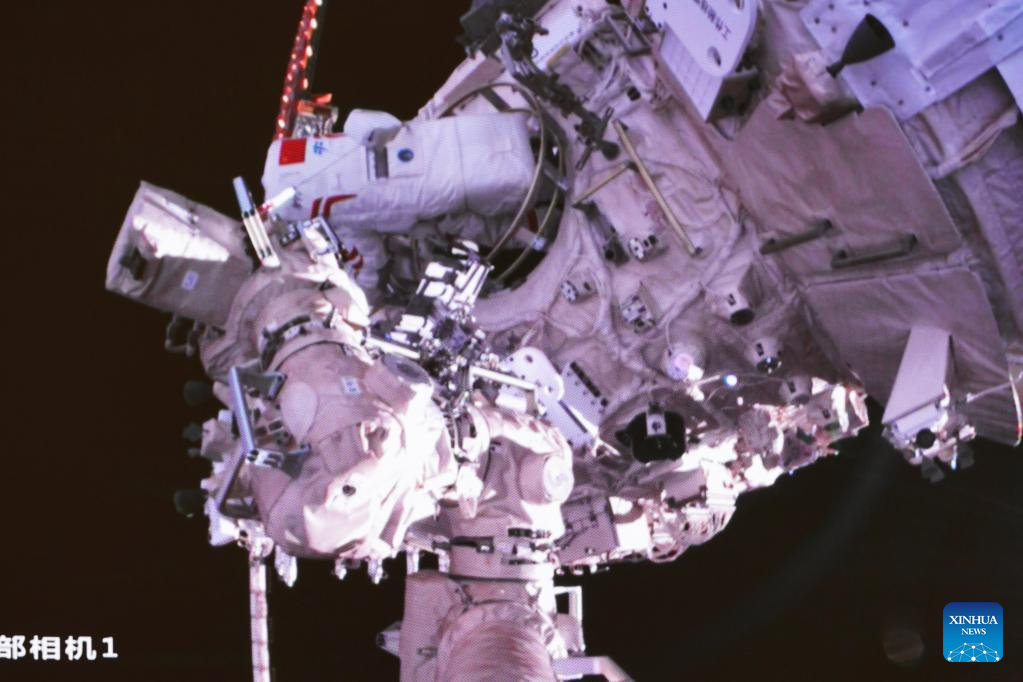
This screen image captured at Beijing Aerospace Control Center on April 15, 2023 shows Shenzhou-15 taikonaut Fei Junlong performing extravehicular activities outside the Wentian lab module. The Shenzhou-15 taikonauts on board the orbiting Chinese Tiangong space station have completed their fourth spacewalk, the China Manned Space Agency said on Sunday. (Xinhua/Guo Zhongzheng)
Quelle: Xinhua
----
Update: 21.04.2023
.
China's Shenzhou 15 astronauts complete record-breaking 4th spacewalk
The crew set a new national record for EVAs during a single mission.

China's Shenzhou 15 astronauts have completed the fourth and final spacewalk of their six-month-long mission.
Mission commander Fei Junlong and Zhang Lu embarked on the extravehicular activity (EVA), exiting via the Wentian science module airlock of the Tiangong space station on Saturday (April 15) Beijing time. Crewmate Deng Qingming assisted operations from inside the outpost.
Fei and Zhang's tasks included installing an external pump set, which is part of Tiangong's coolant system, onto the Mengtian science module. Other completed objectives were installing inter-module cables and devices to support a science and experiment payload hosting platform, according to a statement(opens in new tab) from the China Manned Space Agency.
Shenzhou 15's total of four EVAs during their stay aboard Tiangong is a new national record. The crew had completed their third spacewalk in late March.
As with recent Chinese spacewalks, the activity was conducted without any prior official notification and only few details released after the event. EVAs during the Shenzhou 12, 13 and 14 missions when the three-module Tiangong was being constructed were conducted in a more open fashion.
Fei, Zhang and Deng are expected to leave Tiangong next month, after they greet the upcoming Shenzhou 16mission astronauts and hand over control of the station.
Before this, they will oversee the arrival of the Tianzhou 6 cargo spacecraft to provide fresh supplies to Tiangong for the upcoming mission. The Long March 7 rocket to launch that mission is currently being prepared at Wenchang Satellite Launch Center on the island province of Hainan.
Quelle: SC
----
Update: 24.04.2023
.
China prepping next space station cargo mission for May launch
The Tianzhou 6 mission will carry new supplies to the Tiangong space station in the first half of May.

Components of the Long March 7 rocket that will launch China's Tianzhou 6 cargo mission to the Tiangong space station arrived at the Wenchang Satellite Launch Center on Hainan island on April 13, 2023. (Image credit: CALT)
China is gearing up to send fresh supplies to its space station.
Components of a Long March 7 rocket arrived at the Wenchang Satellite Launch Center on Hainan island, south China, on April 13 after shipping from the northern port city of Tianjin.
The rocket is now being assembled. It will launch the Tianzhou 6 cargo spacecraft to the Tiangong space station in the first half of May.
Tianzhou 6 had earlier been delivered to Wenchang and will carry supplies for astronauts for the Shenzhou 16 and Shenzhou 17 crewed missions, due to launch around late May and November this year, respectively. Tianzhou 6 will also carry propellant to be transferred to Tiangong to allow it to fire its engines and maintain its orbit.
The spacecraft notably features improvements over previous Tianzhou flight modules, according to Chinese space officials.
The manufacturer of Tianzhou spacecraft, the China Academy of Space Technology, has expanded(opens in new tab) the cargo capacity of the pressurized segments of Tianzhou by about 1,100 pounds (500 kilograms). This means that China now needs to launch just three supply missions every two years, instead of launching one every six months.
Tianzhou 6 and the following two Shenzhou crewed missions make up the three missions due to launch to Tiangong this year.
Quelle: SC
----
Update: 8.05.2023
.
China prepares to launch Tianzhou-6 cargo spacecraft

The combination of the Tianzhou-6 cargo spacecraft and a Long March-7 Y7 carrier rocket was vertically transferred to the launching area on Sunday.
The cargo spacecraft will be launched in the near future at an appropriate time, according to the China Manned Space Agency.
The facilities and equipment at the Wenchang Spacecraft Launch Site in China's southern island province of Hainan are in good condition, and various pre-launch function checks and joint tests will be carried out as planned, the agency said in a statement.
Quelle: Xinhua
----
Update: 10.05.2023
.
China's cargo craft Tianzhou-6 ready for launch
China's cargo spacecraft, Tianzhou-6, is ready for launch, according to the Wenchang Spacecraft Launch Site, under the Xichang Satellite Launch Center, in China's southern island province of Hainan.
The launch of Tianzhou-6 will be the first spaceflight since China's space station entered into the application and development stage.
The site has completed all preparations and a final rehearsal for the launch, which comprehensively covered all relevant systems. This process included fueling up the cargo craft and transferring the spacecraft-rocket combination to the launch area.
"This is the most extensive rehearsal before launch, and it is also the final joint rehearsal," said Zhong Wen'an, chief engineer at the Xichang Satellite Launch Center.
The meteorological system at the launch site has strengthened meteorological monitoring to ensure an accurate weather forecast.
"The equipment and facilities are in good condition," Zhong said.
The combination of the Tianzhou-6 cargo spacecraft and a Long March-7 Y7 carrier rocket was vertically transferred to the launching area on Sunday.
Quelle: Xinhua
+++
China to launch cargo craft Tianzhou-6 Wednesday night
China plans to launch the cargo spacecraft Tianzhou-6 from the Wenchang Spacecraft Launch Site in the southern island province of Hainan around 9:22 p.m. (Beijing Time) on Wednesday, according to the China Manned Space Agency.
The Long March-7 Y7 carrier rocket carrying Tianzhou-6 has been filled with propellant and is ready for its planned launch, said the agency.
Quelle: Xinhua
